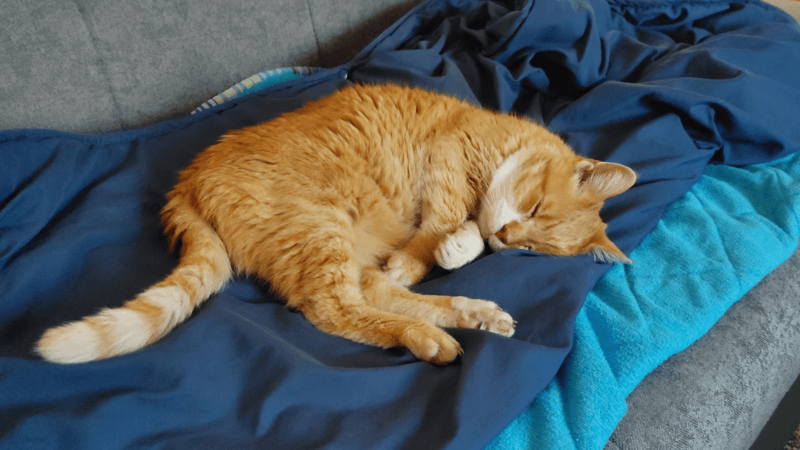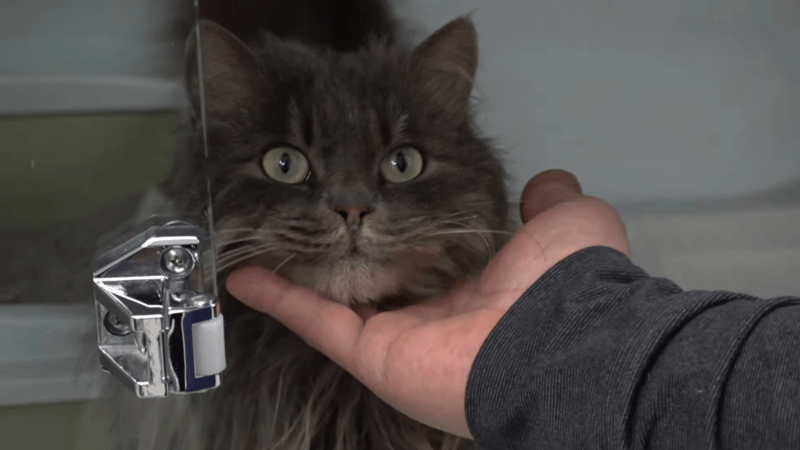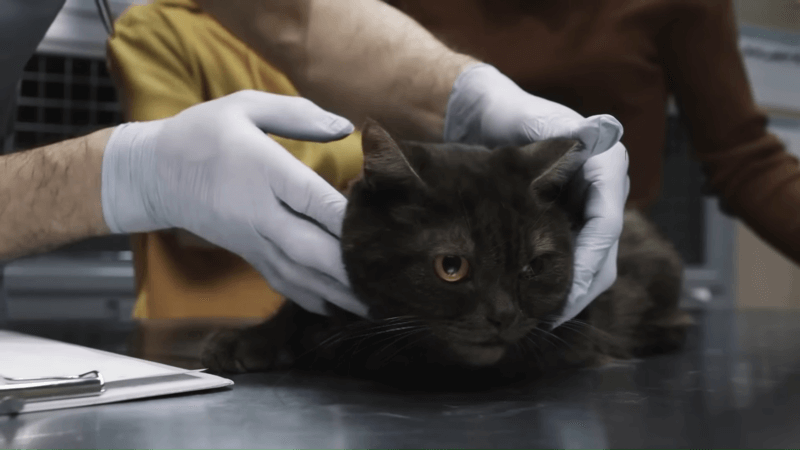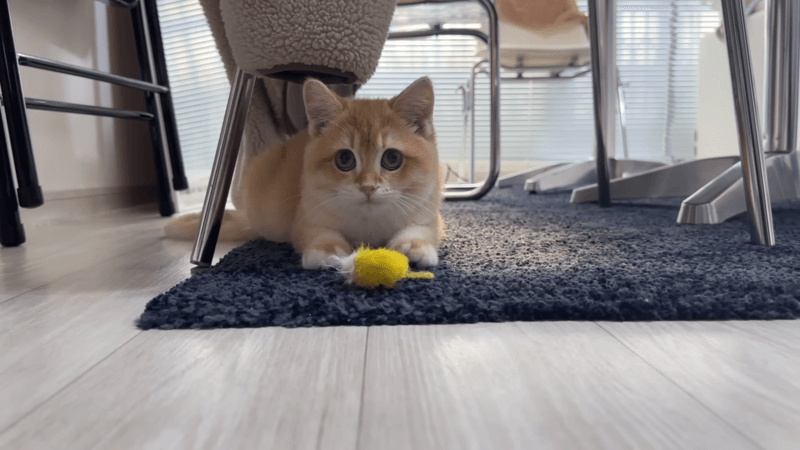No products in the cart.
As we explore solutions for the enigmatic world of feline hyperesthesia, a question comes up, Can CBD Oil Help with Feline Hyperesthesia? This question opens up a realm of possibilities, where anecdotal accounts and preliminary studies hint at the potential benefits of CBD oil in addressing hyperesthesia symptoms in cats. In this blog, we will discover these questions about CBD, such as, Can CBD oil help with feline hyperesthesia? Is CBD oil for cats with hyperesthesia safe? Is hyperesthesia in cats painful?
Can CBD Oil Help with Feline Hyperesthesia?
CBD oil has gained attention as a potential treatment for feline hyperesthesia, although its effectiveness has not been definitively established. Some anecdotal reports and limited studies suggest that CBD oil might help alleviate hyperesthesia symptoms in cats. However, it’s important to note that hyperesthesia is a complex condition, and individual responses to CBD oil can vary. Before deciding to include CBD oil as part of a therapy regimen for feline hyperesthesia, it is imperative to see a veterinarian. More excellent CBD pet items are available at Pet CBD Club.

What is CBD Oil?
CBD is a naturally occurring compound found in cannabis plants, including hemp and marijuana. Unlike its counterpart, THC (tetrahydrocannabinol), CBD does not produce the psychoactive “high” commonly associated with cannabis. CBD oil is derived from these plants and is usually mixed with a carrier oil to create a concentrated solution. It has a reputation for having therapeutic potential and is used by both people and animals to treat a variety of medical ailments.
Potential Benefits of CBD Oil
CBD oil is believed to interact with the endocannabinoid system, a complex network of receptors in the body that helps regulate various physiological processes. For cats with hyperesthesia, the potential benefits of CBD oil might include:
- Pain and Discomfort Relief: CBD oil has anti-inflammatory and analgesic properties that might help reduce pain and discomfort associated with hyperesthesia symptoms.
- Anxiety and Stress Reduction: Cats with hyperesthesia might exhibit increased anxiety and stress. CBD oil is believed to have anxiolytic effects that could help calm nervous behavior.
- Anti-Inflammatory Effects: Hyperesthesia can involve skin sensitivity and inflammation. CBD’s anti-inflammatory properties could aid in managing these aspects of the condition.
- Neuroprotection: CBD’s potential neuroprotective properties might help regulate nerve responses and provide relief from sensory hypersensitivity.
- Improved Quality of Life: By potentially addressing pain, discomfort, and anxiety, CBD oil might contribute to an improved overall quality of life for cats with hyperesthesia.
Ingredients in CBD Oil for Cats
The ingredients in CBD oil for cats can vary depending on the brand and formulation, but the main components typically include:
- CBD Extract: This is the primary active ingredient and contains the cannabidiol compound derived from the cannabis plant.
- Carrier Oil: CBD extract is often mixed with carrier oil to create a suitable concentration and improve absorption. Common carrier oils include coconut oil, olive oil, and hemp seed oil.
- Flavorings: Some CBD oils for cats might include flavorings to make them more appealing to pets. Natural flavors like salmon or chicken are often used.
- Terpenes: Terpenes are aromatic compounds found in cannabis plants that can contribute to the overall therapeutic effects of CBD oil.
Is CBD Oil for Cats with Hyperesthesia Safe?
CBD cat oil can be considered safe for cats with hyperesthesia when used appropriately and under the guidance of a veterinarian. However, like any supplement or treatment, there are factors to consider:
- Dosage: The correct dosage is crucial. Too much CBD oil can lead to adverse effects, while too little might not be effective. Consult your veterinarian to determine the appropriate dosage for your cat’s size and condition.
- Quality: Choose high-quality CBD oil products specifically designed for pets. Look for products that have undergone third-party testing for potency and purity.
- THC Content: Ensure that the CBD oil you choose contains very low levels of THC (tetrahydrocannabinol), as THC can be toxic to cats. Legal CBD products for pets should have less than 0.3% THC.
- Ingredients: Check the product’s ingredients list for any additives or harmful substances that could be detrimental to your cat’s health.

Side Effects Associated with Using CBD Oil for Feline Hyperesthesia
While side effects from CBD oil are generally rare in cats, some potential side effects might include:
- Sedation: Cats might experience mild sedation, especially if given higher doses of CBD oil.
- Gastrointestinal Upset: Some cats might experience digestive issues, such as vomiting or diarrhea, after taking CBD oil.
- Dry Mouth: CBD oil might lead to a decrease in saliva production, causing temporary dry mouth.
- Interaction with Medications: CBD oil might interact with other medications your cat is taking. It’s important to consult a veterinarian if your cat is on any medication.
What to Consider When Selecting a CBD Oil Product
When choosing a CBD oil product for your cat with hyperesthesia, keep these factors in mind:
- Source: Opt for CBD oil derived from high-quality hemp plants and manufactured by reputable companies.
- Third-Party Testing: Ensure the product has been tested by an independent third-party lab for potency, purity, and the absence of contaminants.
- THC Content: Check the product’s THC content to ensure it’s within the safe range for cats.
- Dosage Instructions: Choose a product that provides clear dosage instructions suitable for cats.
- Formulation: Select CBD oil formulated specifically for pets. Avoid using CBD products meant for humans, as they might contain ingredients that are unsafe for cats.
- Natural Flavors: If the product is flavored, ensure it uses natural flavors like salmon or chicken, as artificial additives can be harmful.
- Consult Your Veterinarian: Always consult your veterinarian before introducing any new supplement, including CBD oil, into your cat’s routine. Your vet can provide personalized advice based on your cat’s health.
Is Hyperesthesia in Cats Painful?
Yes, hyperesthesia in cats can be painful. Hyperesthesia, often referred to as “rolling skin syndrome” or “feline hyperesthesia syndrome,” is a neurological condition that causes heightened sensitivity in a cat’s skin. This heightened sensitivity can lead to discomfort, tingling sensations, and sometimes even pain. Cats with hyperesthesia may exhibit behaviors that suggest discomfort, such as excessive grooming, scratching, biting at their skin, and exhibiting signs of agitation. The discomfort experienced by cats with hyperesthesia can vary in intensity.

How Does Hyperesthesia Manifest in Cats?
Hyperesthesia is characterized by abnormal and exaggerated reactions to sensory stimuli, particularly touch, sound, and movement. It typically manifests in the following ways:
- Skin Rippling or Twitching: One of the most distinctive signs of hyperesthesia is the rippling or twitching of the skin, especially along the cat’s back. This can occur spontaneously or in response to touch or other stimuli.
- Excessive Grooming: Cats with hyperesthesia often engage in excessive grooming, particularly over the area where they experience sensitivity. This behavior can lead to hair loss, bald patches, and even skin irritation.
- Tail Lashing or Twitching: Some cats with hyperesthesia exhibit sudden, uncontrolled tail movements, including lashing or twitching. This behavior is often unrelated to normal tail movements and can occur spontaneously.
- Dilated Pupils: Cats with hyperesthesia may have dilated pupils, suggesting heightened arousal or discomfort.
- Agitation and Restlessness: Affected cats might show signs of restlessness, agitation, or anxiety. They may exhibit pacing behavior or seem unable to settle comfortably.
- Vocalization: Cats with hyperesthesia may vocalize more than usual, meowing excessively or making unusual sounds in response to their discomfort.
- Biting at the Skin: Some cats may bite at their own skin, particularly the area affected by hyperesthesia. This behavior can lead to further irritation and potential injury.
- Sensitivity to Touch: Cats with hyperesthesia often display heightened sensitivity to touch, especially along their spine. They might react strongly, sometimes with vocalizations or sudden movements, when this area is touched.
Common Symptoms of Hyperesthesia
- Skin Rippling or Twitching: Cats with hyperesthesia often display sudden and uncontrolled rippling or twitching of the skin, especially along the back.
- Excessive Grooming: Affected cats may excessively groom the area of their body that is experiencing heightened sensitivity. This can lead to hair loss, bald patches, and skin irritation.
- Tail Lashing: Cats might exhibit tail lashing, where their tail moves rapidly and uncontrollably, seemingly without a specific trigger.
- Dilated Pupils: Cats with hyperesthesia may have dilated pupils, which can indicate heightened arousal or discomfort.
- Restlessness: Hyperesthetic cats may appear restless, pacing back and forth or being unable to settle comfortably.
- Vocalization: Some cats may vocalize more than usual, meowing excessively or making unusual sounds in response to the discomfort they’re experiencing.
- Biting or Scratching: Cats might bite or scratch at their own skin, particularly in the sensitive area. This behavior can lead to further skin irritation.
- Sensitivity to Touch: Cats with hyperesthesia may react strongly when touched along their back, often with a vocal response or sudden movement.
- Panic Episodes: In severe cases, cats might experience episodes of panic or extreme agitation, during which they may run, jump, or act out of character.
- Agitation and Anxiety: Hyperesthetic cats may exhibit signs of anxiety, such as increased alertness, restlessness, and an overall agitated demeanor.
- Behavioral Changes: Some cats might exhibit changes in behavior, becoming more withdrawn or displaying unusual behavior patterns.
Conclusion
Can CBD oil really help with feline hyperesthesia? While its benefits offer hope, the path to alleviating this condition requires cautious steps guided by veterinary expertise. The collaboration between CBD oil’s potential and professional guidance holds the key to unlocking relief for our feline companions suffering from hyperesthesia.
I am Nelson Cooper, I pursue my passion for writing and my belief is that cats love humans. I enjoy traveling and have a deep appreciation for the beauty of nature, as well as a soft spot for animals, particularly cats.



